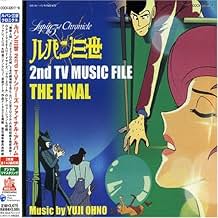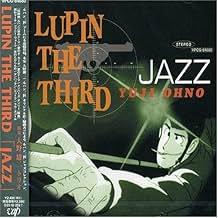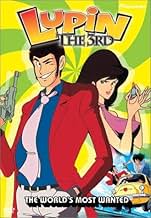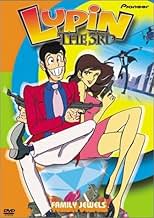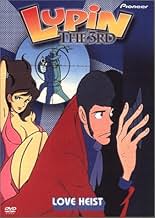VALUTAZIONE IMDb
8,0/10
2081
LA TUA VALUTAZIONE
Il maestro ladro Lupin III e i suoi amici continuano le loro imprese da giro del mondo, con l'ostinato ispettore Zenigata sempre alle loro tracce.Il maestro ladro Lupin III e i suoi amici continuano le loro imprese da giro del mondo, con l'ostinato ispettore Zenigata sempre alle loro tracce.Il maestro ladro Lupin III e i suoi amici continuano le loro imprese da giro del mondo, con l'ostinato ispettore Zenigata sempre alle loro tracce.
Sfoglia gli episodi
Recensioni in evidenza
The first episode of the series re-unites Japan's favorite comic felon with his gang: crack shot Jigen, steely samurai Goemon and devious ex- girlfriend Fujiko on a cruise that turns out to have a surprise party scheduled just for them! The action moves on through a dizzying blur of international hot spots as the gang attempt one wildly improbable heist after another, usually with unexpected results. Past enemies from the earlier TV show make return appearances, and the Loch Ness Monster has a guest spot. The series creators stick closely to manga artist Monkey Punch's distinctive Sergio Aragones-influenced cartoon style, which is both a plus and a minus; everything has a uniform kookiness that can sometimes be distracting, especially when the setting requires a posh look.
In addition to the elaborate heists which characterize the series, occasional episodes go seriously weird and mystical, with lots of mind- bendingly surreal elements: telepaths, beams that induce suicide, a nun who deals in mass hypnosis (!) to name a few. Series villains often sport the towering arrogance and ambitions of James Bond supervillains.
This series really hit its stride in the second season with a run of truly fine episodes. Great heist action, elaborate chases, exotic locations and outrageousness are all featured here as Lupin's gang tries to recover Peking Man's Bones, steal a golden lion from the Australian government, rob a casino and finally steal the crown jewels of England. This final episode is the best of the disc as Lupin disrupts a royal wedding to get a crack at her majesty's crown!
Fast moving, with good looking action animation and well written (if often wildly implausible) heist schemes, untimely double-crosses and good background art depicting the globe scattered locations, there is lot here to enjoy.
In addition to the elaborate heists which characterize the series, occasional episodes go seriously weird and mystical, with lots of mind- bendingly surreal elements: telepaths, beams that induce suicide, a nun who deals in mass hypnosis (!) to name a few. Series villains often sport the towering arrogance and ambitions of James Bond supervillains.
This series really hit its stride in the second season with a run of truly fine episodes. Great heist action, elaborate chases, exotic locations and outrageousness are all featured here as Lupin's gang tries to recover Peking Man's Bones, steal a golden lion from the Australian government, rob a casino and finally steal the crown jewels of England. This final episode is the best of the disc as Lupin disrupts a royal wedding to get a crack at her majesty's crown!
Fast moving, with good looking action animation and well written (if often wildly implausible) heist schemes, untimely double-crosses and good background art depicting the globe scattered locations, there is lot here to enjoy.
Second television series of the most famous thief ever, certainly the best known and most representative of all. As well as the longest produced so far, with 155 episodes.
The second series is certainly the one that has been more successful and definitively affirmed the character of Lupin. Our protagonist is presented to us with a new and flamboyant look and his unforgettable red jacket.
From the beginning we notice some substantial differences with the previous series: here we have a globetrotting, adventurer Lupin. Almost every episode is set in a different country and we see Lupin meet all kinds of antagonists, from the simplest to the most imaginative.
It's a very adventure-focused series, unlike the first one, which was almost entirely set in Japan.
Another very important difference compared to the series with the green jacket is Lupin's character: if in the first series we had a noir, ruthless and unscrupulous Lupin; here we have a slightly more light-hearted protagonist. The tones of the series are much more cheerful and Lupin is much more heroic and forgiving. We will hardly see him kill someone... On the other hand, his typical determination will not be missing, which will lead him to never give up in order to reach his goal.
Obviously such a long series cannot be without flaws. In fact, the large number of episodes sometimes has a negative effect, as we will happen to see very beautiful and compelling episodes (for example those directed by Hayao Miyazaki) and decidedly bad, boring or completely meaningless episodes full of errors.
In conclusion: I personally find this series excellent and enjoyable. Rich in facets and capable of enthralling all types of spectators. Thanks also to his styles, different in each episode.
On the other hand, for lovers of Lupin in a green jacket this series could be more childish and sweetened.
That said, I highly recommend you to see it and enjoy it.
It will certainly take some time, but it will be worth it.
Good vision.
The second series is certainly the one that has been more successful and definitively affirmed the character of Lupin. Our protagonist is presented to us with a new and flamboyant look and his unforgettable red jacket.
From the beginning we notice some substantial differences with the previous series: here we have a globetrotting, adventurer Lupin. Almost every episode is set in a different country and we see Lupin meet all kinds of antagonists, from the simplest to the most imaginative.
It's a very adventure-focused series, unlike the first one, which was almost entirely set in Japan.
Another very important difference compared to the series with the green jacket is Lupin's character: if in the first series we had a noir, ruthless and unscrupulous Lupin; here we have a slightly more light-hearted protagonist. The tones of the series are much more cheerful and Lupin is much more heroic and forgiving. We will hardly see him kill someone... On the other hand, his typical determination will not be missing, which will lead him to never give up in order to reach his goal.
Obviously such a long series cannot be without flaws. In fact, the large number of episodes sometimes has a negative effect, as we will happen to see very beautiful and compelling episodes (for example those directed by Hayao Miyazaki) and decidedly bad, boring or completely meaningless episodes full of errors.
In conclusion: I personally find this series excellent and enjoyable. Rich in facets and capable of enthralling all types of spectators. Thanks also to his styles, different in each episode.
On the other hand, for lovers of Lupin in a green jacket this series could be more childish and sweetened.
That said, I highly recommend you to see it and enjoy it.
It will certainly take some time, but it will be worth it.
Good vision.
With the main problem being the lackluster, progressive cartoonification of the traits of the characters from the first part, being that of Rupan Sansei progressively becoming less and less a gentleman's thief and more a stupid's thief who throws away a fortune for a billionaire groupie, Fujiko Mine (who, incredibly enough, is the only one showing proper thievery, crime skills, guts and intelligence amongst all the Rupan Sansei group) progressively and forcibly presented as ONLY interested in monetary gain and nothing else and when she doesn't show that is reprimanded because of 70's sexism, Jigen is slowly reduced to a caricature spouting misoginyst lines who the facto does not act as a misogyn because reasens and Goemon is out there doing stuff. And unfortunately, by season three, the writing which in season one and two was pretty good turned from acceptable to bad to godawful with a whole slew of badly written, nonsensical episodes where things happened with no resonance whatsoever, with the only saving point of again showing the intelligence of the real leader of the Rupan Sansei gang (you guessed it, her name being Fujiko Mine) and nothing else. I was onboard with the idea of throwing the characters in more out-of-this world, wacky situations a là Silver Age but not at the expense of bad writing and ridiculization of their main characteristics. My rating for this series is 8 for the first two seasons and 5 for the third one, which I dropped by episode 89, hence a generous 7. I won't bother with the fourth season.
Most people in the US get acquainted with the Lupin III series via Hayao Miyazaki's debut film, The Castle of Cagliostro (1979) or this 1977 TV series which briefly aired on Adult Swim a few years ago. While it never made a hit on Adult Swim, this series was a smash in the late 1970s, the result of the franchise's renewed popularity which came from reruns of the 1971 Lupin anime.
Personally, I prefer the 1971 Lupin anime to this later incarnation. Despite the super limited animation and uneven tone over the 23 episodes, it broke more ground, feels more adult, and is less repetitive. However, that does not mean the second Lupin TV series is not worth your time. It's a fun, goofy romp of a show, one that can prove addictive if you're craving insane humor and quasi-surreal action. Yuji Ohno's soundtrack is superb, the essence of 1970s cool.
Also, the Geneon English dub isn't half bad. All the voice actors do their characters justice and seem to be having fun. This is a good series, one that deserves more than the lukewarm reception it received in the States.
Personally, I prefer the 1971 Lupin anime to this later incarnation. Despite the super limited animation and uneven tone over the 23 episodes, it broke more ground, feels more adult, and is less repetitive. However, that does not mean the second Lupin TV series is not worth your time. It's a fun, goofy romp of a show, one that can prove addictive if you're craving insane humor and quasi-surreal action. Yuji Ohno's soundtrack is superb, the essence of 1970s cool.
Also, the Geneon English dub isn't half bad. All the voice actors do their characters justice and seem to be having fun. This is a good series, one that deserves more than the lukewarm reception it received in the States.
TL;DR: Though many of its episodes are more resembling of an old saturday morning cartoon, the quality in writing and funny (although quite campy) jokes make this series a superb comfort watch when you just want some well-done baseline Lupin III. Perfect for someone new to the Lupin III franchise to begin with.
Now to get into the long-form review:
This. This is what Lupin III should be in all its glory. This ancient anime set the standard for a dynasty that is still going to this day and is gaining more and more praise and fame across the world. Even though it is only the second series in the Lupin III franchise, it has managed to surpass the first by adopting a much lighter tone (although the later episodes of part 1 also laid the groundwork for this tonal shift), Yuji Ohno's superb work on the soundtrack and most crucially; the first English dub from what can now be called the greatest dub cast of the franchise.
It is for that reason why I recommend you watch the 2004 Geneon dub: even though its writing is heavily modified from the original Japanese dub and its animation is a bit shoddily adapted to this fact (especially in the first couple of episodes), the sheer hilarity campiness of the early 2000's dialogue can't be found anywhere else in the franchise.
I wouldn't really advise to watch this series from episode one 1 to 79 (yes, unfortunately only 79 of 155 episodes were dubbed), rather looking up a list of its episodes online (for instance here in IMDb) and just picking what you find interesting from reading the synopsis; due to a complete lack of continuity you can just tune in with any episode and get a unique story.
The episodes themselves can be categorized into three categories: 20% are true classics, 65% are fun for a comfort watch and 15% range from mediocre to downright awful. It is for this reason that I implore any new viewer to just explore the series on their own pace to test the waters and see what they like.
The series does have one pretty annoying aspect that can turn some viewers off of it; the animation. Even though it isn't bad for 1977, it still leaves a lot of room for improvement when you are used to the modern standard of animation in anime (and the latest installments of Lupin III). Some backgrounds loop too early, characters stand still for a bit too long, et cetera et cetera. Nothing out of the ordinary for cash-strapped TMS. Especially the English dub also suffers from poorly looped speech animations in its earlier episodes; if you have a strong distaste for poor animation, this series might not be for you.
However, the best part for the keen listener will be the soundtrack. This was the first series in which Yuji Ohno was involved with the soundtrack, and he hasn't been absent ever since for a very good reason. Comparing the sound design from part 1 to part 2 is comparing the sword to the rifle; there is simply no competition. In the series Ohno's masterful jazz fusion tracks are played near-constantly, and if you appreciate "70's groove" and a bit of spy movie aesthetic this series is practically Valhalla.
In conclusion; this is the true establishing ground for what Lupin III became. The English cast, the music and the style all originated from this series, and it still holds up as the baseline for any experience watching something from this storied franchise. Lupin III has his classic look, his classic gang and his classic adventures. If you want to get into the franchise without any previous engagement with Lupin III, here's where you start.
Now to get into the long-form review:
This. This is what Lupin III should be in all its glory. This ancient anime set the standard for a dynasty that is still going to this day and is gaining more and more praise and fame across the world. Even though it is only the second series in the Lupin III franchise, it has managed to surpass the first by adopting a much lighter tone (although the later episodes of part 1 also laid the groundwork for this tonal shift), Yuji Ohno's superb work on the soundtrack and most crucially; the first English dub from what can now be called the greatest dub cast of the franchise.
It is for that reason why I recommend you watch the 2004 Geneon dub: even though its writing is heavily modified from the original Japanese dub and its animation is a bit shoddily adapted to this fact (especially in the first couple of episodes), the sheer hilarity campiness of the early 2000's dialogue can't be found anywhere else in the franchise.
I wouldn't really advise to watch this series from episode one 1 to 79 (yes, unfortunately only 79 of 155 episodes were dubbed), rather looking up a list of its episodes online (for instance here in IMDb) and just picking what you find interesting from reading the synopsis; due to a complete lack of continuity you can just tune in with any episode and get a unique story.
The episodes themselves can be categorized into three categories: 20% are true classics, 65% are fun for a comfort watch and 15% range from mediocre to downright awful. It is for this reason that I implore any new viewer to just explore the series on their own pace to test the waters and see what they like.
The series does have one pretty annoying aspect that can turn some viewers off of it; the animation. Even though it isn't bad for 1977, it still leaves a lot of room for improvement when you are used to the modern standard of animation in anime (and the latest installments of Lupin III). Some backgrounds loop too early, characters stand still for a bit too long, et cetera et cetera. Nothing out of the ordinary for cash-strapped TMS. Especially the English dub also suffers from poorly looped speech animations in its earlier episodes; if you have a strong distaste for poor animation, this series might not be for you.
However, the best part for the keen listener will be the soundtrack. This was the first series in which Yuji Ohno was involved with the soundtrack, and he hasn't been absent ever since for a very good reason. Comparing the sound design from part 1 to part 2 is comparing the sword to the rifle; there is simply no competition. In the series Ohno's masterful jazz fusion tracks are played near-constantly, and if you appreciate "70's groove" and a bit of spy movie aesthetic this series is practically Valhalla.
In conclusion; this is the true establishing ground for what Lupin III became. The English cast, the music and the style all originated from this series, and it still holds up as the baseline for any experience watching something from this storied franchise. Lupin III has his classic look, his classic gang and his classic adventures. If you want to get into the franchise without any previous engagement with Lupin III, here's where you start.
Lo sapevi?
- QuizThe series, more parody-based than its predecessor, has referenced/satirized a number of international celebrities, such as Alan Delon, Pele, Jacqueline Kennedy, and Aristotle Onassis (to avoid legal repercussions, the names have intentionally been changed by home video distributor Geneon to Japanese romanized spellings), as well as frequently parodying 1970s American movies and TV shows.
- Curiosità sui creditiThe first season's opening credits has Zenigata chasing Lupin's gang across a desert, accompanied by five vignettes that focus on each character:
- Lupin breaks into Fujiko's bedroom
- Jigen shoots down an airplane
- Fujiko machine-guns down a shooter behind a door
- Goemon slices a plane in half
- and Zenigata continues to chase Lupin.
- Versioni alternativeA few changes were made for the US television and DVD releases. First, the episode "Hitler's Legacy" was removed from its space as episode three, to be reintroduced at a later date. (This was done to forestall potential protests about the episode, which used the Nazis as low comedy, including title character Lupin dressing up as Hitler.) Further, TMS gave Pioneer edited masters that had unspecified cuts and edits made to excise real-world corporate and product logos and copyrighted music snippets to prevent lawsuits. Pioneer has said that "Hitler's Legacy" will appear on a later DVD in the series' release: No word on whether the episode will appear on television.
- ConnessioniEdited into Rupan sansei: The shooting (2001)
I più visti
Accedi per valutare e creare un elenco di titoli salvati per ottenere consigli personalizzati
Dettagli
- Data di uscita
- Paese di origine
- Sito ufficiale
- Lingue
- Celebre anche come
- Lupin the Third: Part II
- Azienda produttrice
- Vedi altri crediti dell’azienda su IMDbPro
Contribuisci a questa pagina
Suggerisci una modifica o aggiungi i contenuti mancanti

Divario superiore
By what name was Le nuove avventure di Lupin III (1977) officially released in India in English?
Rispondi
